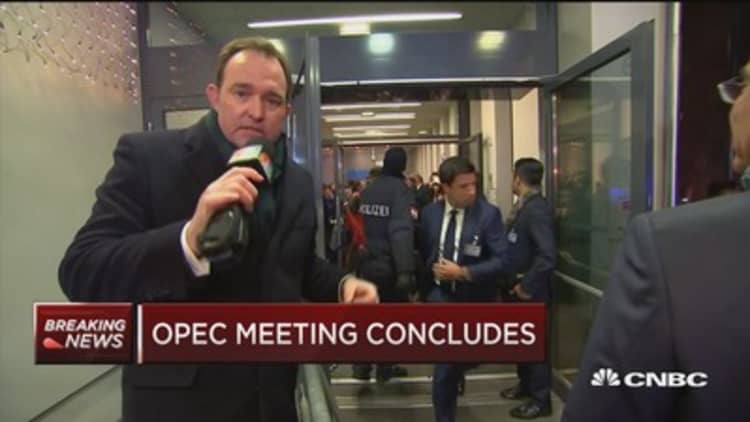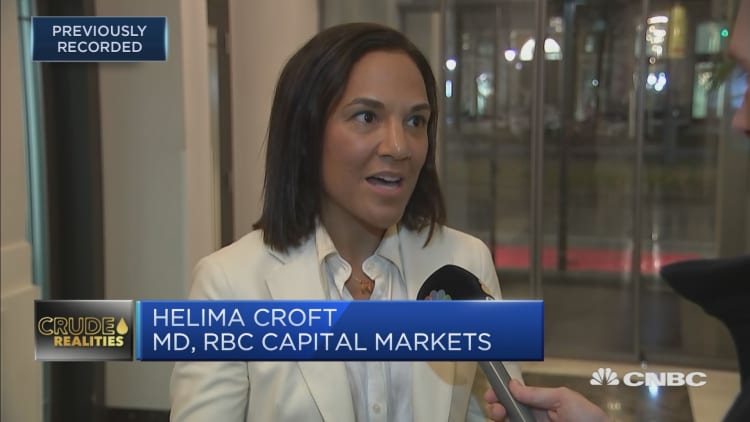
Global oil-producing group OPEC reportedly considered cutting production by an additional 500,000 barrels per day as its biannual meeting kicked off Thursday in Vienna.
The meeting of the 14-member cartel ended just after 11 p.m. local time. While initially it was unclear if a deal had been reached, Dow Jones reported that Iran's oil minister said a deal had been reached although he would not comment further.
Earlier, sources told CNBC'S Brian Sullivan that the organization still had multiple issues to resolve, and just before 4 p.m. ET OPEC announced that it was canceling its customary press conference that usually follows the meeting.
The reported 500,000 cut is larger than the numbers floated ahead of the meeting. It would bring the total production cut to 1.7 million barrels per day. On Friday, OPEC and its allies — known as OPEC+ and which includes Russia — will meet to finalize any proposed measures, including how any cuts would be implemented by each country.
Earlier Thursday, Russian Energy Minister Alexander Novak said that the steeper cuts would extend through the first quarter of 2020 and would only be implemented if each member complies with its current production quota.
Novak also said, according to reports, that condensates would no longer be quoted as part of output for countries, a move which would reduce the total impact of the cuts.
In after hours trading international benchmark Brent crude gained 21 cents to trade at $63.21. U.S. West Texas Intermediate shed 10 cents to trade at $58.33.
The deeper-than-expected cut might not have all that much of an impact on oil prices, however, since ahead of Thursday's meeting OPEC+, as a whole, was not even pumping as much as allotted. Saudi Arabia, which has been producing less than allowed, has been adamant about other producers, that are overproducing, complying with their quota.
"Everyone's starting to do math. Between the condi [condensates] exemption and the current rate of over compliance, it's not really a new larger cut," Again Capital's John Kilduff said to CNBC. "It doesn't look promising to me," he added after the meeting concluded.
But a long meeting followed by an unclear decision is not without precedent, noted RBC's Helima Croft. She pointed to last year's meeting, when the cartel was initially divided over the 1.2 million barrels a day cut, as evidence that all might not be lost.
As OPEC+ prepares to meet on Friday, Croft said Iraq's production will be among the things in focus. "The optics are not that great right now in terms of whether people will honor their commitments," she said.
What's the context?
The OPEC+ group (amounting to 24 countries) has cut its collective production since January 2017 in a bid to counter increasing global oil supply from the likes of U.S. shale oil producers and lackluster demand.
OPEC+ was prompted to act after global oil prices tumbled in mid-2014 due to an oversupply but U.S. shale producers are not a part of the deal and shale oil supply has grown exponentially. The U.S. is now the world's largest oil producer hitting 12.3 million bpd in 2019, according to the U.S. Energy Information Administration, up from 11 million bpd in 2018. It produces more oil than Saudi Arabia and Russia now, although there are signs that production growth is slowing in the States.
Along with rampant shale supply, faltering demand due to a global economic slowdown, exacerbated by the Sino-U.S. trade war, has once again threatened to unbalance oil supply and demand dynamics.

- CNBC's Patti Domm contributed reporting.

